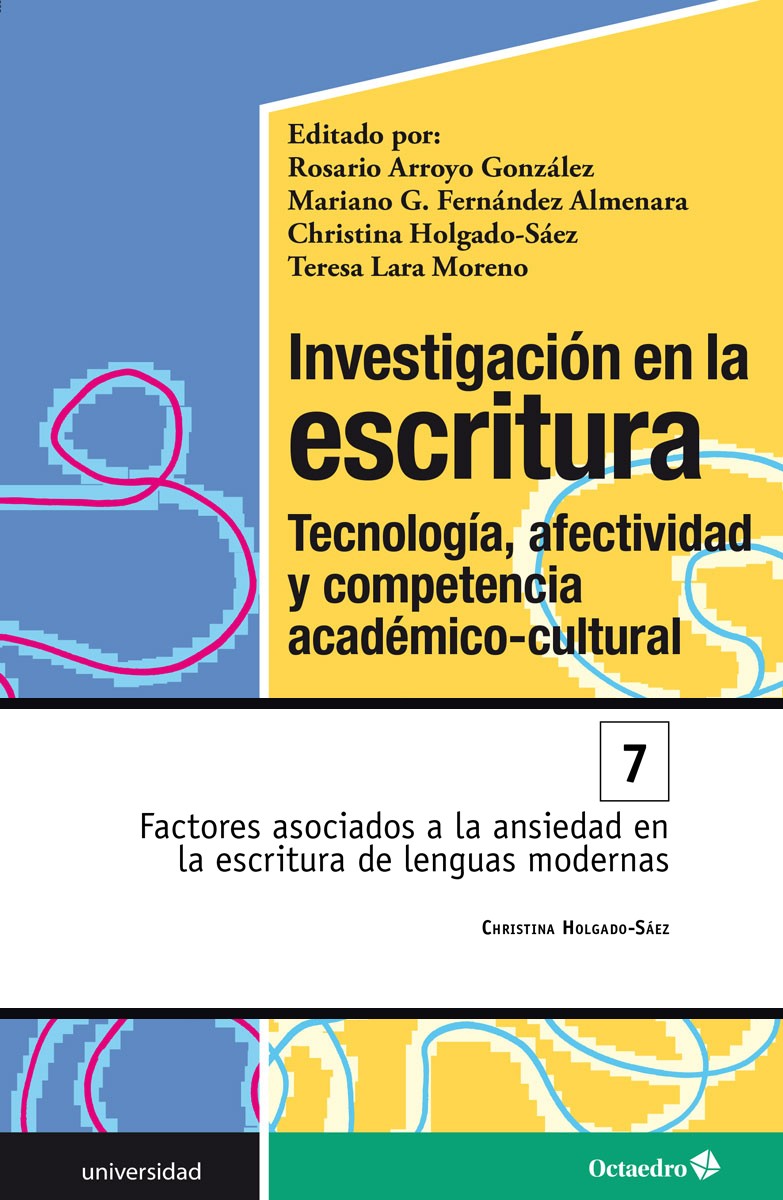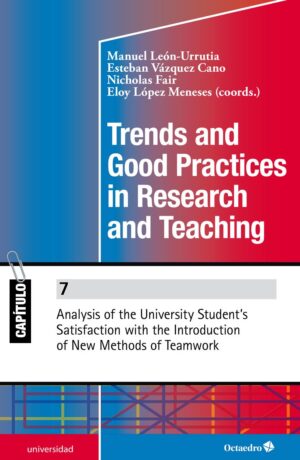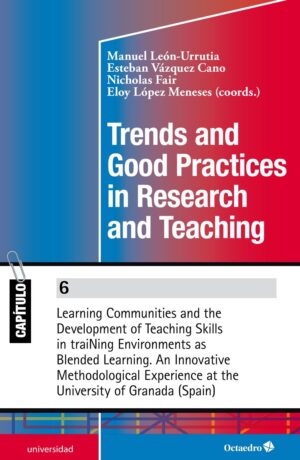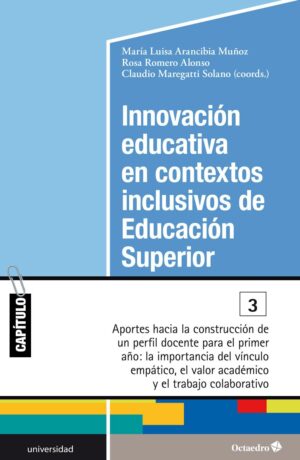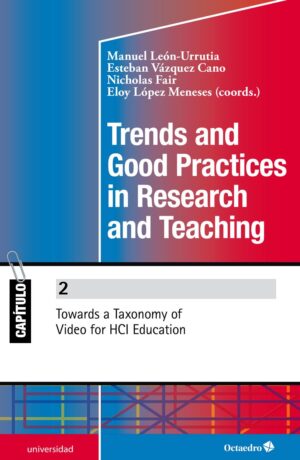FICHA TÉCNICA
Fecha de publicación:
01/07/2020
DOI: https://doi.org/10.36006/16143-07
Título del libro: a:3:{s:5:"title";s:30:"Investigación en la escritura";s:3:"url";s:59:"https://octaedromx.com/libro/investigacion-en-la-escritura/";s:6:"target";s:0:"";}
URL del libro: a:3:{s:5:"title";s:30:"Investigación en la escritura";s:3:"url";s:59:"https://octaedromx.com/libro/investigacion-en-la-escritura/";s:6:"target";s:0:"";}
ISBN:
DOI del libro: https://doi.org/10.36006/16143
Abstract
Investigadores y teóricos han sido conscientes de que la ansiedad se relaciona con el aprendizaje de segundas lenguas o lenguas extranjeras. Como resultado de estas situaciones afectivas, se analizan los factores asociados a la ansiedad en la escritura de una L2 y se aporta un instrumento denominado second language writing anxiety inventory (SLWAI), el cual determina los niveles y tipos de esta ansiedad.
Palabras clave
Autores
Cómo citar
Holgado-Sáez, C. (2018). Enseñanza de la escritura en Moodle de un modo multilingüe. En Arroyo González, R; Fernández Almenara, M. G.; Holgado-Sáez, C. y Lara Moreno, T. Factores asociados a la ansiedad en la escritura de lenguas modernas. Barcelona: Octaedro. https://doi.org/xxxxxxx-16143-07
Referencias bibliográficas
- Brand, A. G. (1987). «The why of cognition: emotion and the writing process». College Composition and Communication, 38: 436-443.
- Cayton, M. K. (1990). «What happens when things go wrong: women and writing blocks». Journal of Advanced Composition, 10 (2): 321-337.
- Cheng, Y. S. (2004). «A measure of second language writing anxiety: scale development and preliminary validation». Journal of Second Language Writing, 13: 313-335.
- Cheng, Y. S. (2002). «Factors associated with foreign language writing anxiety». Foreign Language Annals, 35 (5): 647-656.
- Cheng, Y. S.; Horwitz, E.; Schallert, D. (1999). «Language anxiety: differentiating writing and speaking components». Language Learning, 49 (3): 417-446.
- Çinar Yastibaş, G.; Erdost Yastibaş, A. (2015). «The effect of peer feedback on writing axiety in Turkish EFL (English as a foreign language) students». Procedia-Social and Behavioral Sciences, 199: 530-538.
- Daly, J. A. (1978). «Writing apprehension and writing competency». The Journal of Educational Research, 72 (1): 10-14.
- Daly, J. A.; Miller, M. D. (1975). «Further studies in writing apprehension: SAT scores, success, expectations, willingness to take advanced courses, and sex differences». Research in the Teaching of English, 13: 37-45.
- DeDeyn, R. (2011). Student identity, writing anxiety, and writing performance: a correlational study (tesis no publicada). Colorado State University: Colorado. Recuperado el 4 de junio de 2017 de: https://goo.gl/aPC5nL.
- Dracopoulus, E.; Pichette, F. (2011). «Second language writing anxiety, computer anxiety, and performance in a classroom versus a web-based environment». Studies in Second Language Learning and Teaching, 1 (1): 101-117.
- Gardner, R. C. (1985). Social psychology and second language learning: The role of attitudes and motivation. Londres: Edward Arnold.
- Gregersen, T. S. (2003). «To err is human: A reminder to teachers of language-anxious students». Foreign Language Annals, 36 (1): 25-32.
- Hassan, B. A. (2001). The relationship of writing apprehension and self-esteem to the writing quality and quantity of EFL university students. Recuperado el 4 de junio de 2017 de: https://goo.gl/EgDPr9.
- Horwitz, E. K. (2010). «Foreign and second language anxiety». Language Teaching, 43 (2), 154-167. DOI: 10.1017/S026144480999036X.
- Horwtiz, E. K.; Horwitz, M. B.; Cope, J. (1986). «Foreign language classroom anxiety». The Modern Language Journal, 70: 125-132.
- Hurd, S. (2007). «Anxiety and non-anxiety in a distance language learning environment: the distance factor as a modifying influence». System, 35 (4): 487-508.
- Jebreil, N.; Azizifar, A.; Gowhary, H.; Jamalinesari, A. (2014). «A Study on writing anxiety among Iranian EFL students». International Journal of Applied Linguistics & English Literature, 4 (2): 68-72.
- Lehrer, P. M.; Goldman, N. S.; Strommen, E. F. (1990). «A principal components assessment of performance anxiety among musicians». Medical Problems of Performing Artists, 5 (1): 12-18.
- Leki, I. (1999). «Techniques for reducing second language writing anxiety». En: D. J. Young (ed.). Affect in foreign language and second language learning: A practical guide to creating a low-anxiety classroom atmosphere (pp. 64-88). Boston: McGraw-Hill.
- MacIntyre, P. D.; Gardner, R. C. (1991). «Methods and results in the study of anxiety and language learning: a review of the literature». Language Learning, 41 (1): 85-117.
- McKain, T. L. (1991). Cognitive, affective, and behavioral factors in writing anxiety (tesis doctoral no publicada). Washington, D.C.: Universidad Católica de América.
- Philips, E. M. (1992). «The effects of language anxiety on students’ oral test performance and attitudes». The Modern Language Journal, 88: 403-415.
- Pichette, F. (2009). «Second language anxiety and distance language learning». Foreign Language Annals, 42: 77-93.
- Saito, Y.; Horwitz, E. K.; Garza, T. J. (1999). «Foreign language reading anxiety». Modern Language Journal, 83: 202-218.
- Scovel, T. (1978). «The effect of affect on foreign language learning: a review of the anxiety research». Language Learning, 28: 129-142.
- Sellers, V. (2000). «Anxiety and reading comprehension in Spanish as a foreign language». Foreign Language Annals, 33: 512-521.
- Teranishi Martínez, C.; Kock, N.; Cass, J. (2011). «Pain and pleasure in short essay writing: factors predicting university students’ writing anxiety and writing self-efficacy». Journal of Adolescent & Adult Literacy, 54 (5): 351-360.
- Tyrer, P. (1999). Anxiety: a multidisciplinary review. Londres: Imperial College Press.
- Vogely, A. J. (1998). «Listening comprehension anxiety: students’ reported sources and solutions». Foreign Language Journal, 31: 67-80.
Mostrar referencias bibliográficas
- Brand, A. G. (1987). «The why of cognition: emotion and the writing process». College Composition and Communication, 38: 436-443.
- Cayton, M. K. (1990). «What happens when things go wrong: women and writing blocks». Journal of Advanced Composition, 10 (2): 321-337.
- Cheng, Y. S. (2004). «A measure of second language writing anxiety: scale development and preliminary validation». Journal of Second Language Writing, 13: 313-335.
- Cheng, Y. S. (2002). «Factors associated with foreign language writing anxiety». Foreign Language Annals, 35 (5): 647-656.
- Cheng, Y. S.; Horwitz, E.; Schallert, D. (1999). «Language anxiety: differentiating writing and speaking components». Language Learning, 49 (3): 417-446.
- Çinar Yastibaş, G.; Erdost Yastibaş, A. (2015). «The effect of peer feedback on writing axiety in Turkish EFL (English as a foreign language) students». Procedia-Social and Behavioral Sciences, 199: 530-538.
- Daly, J. A. (1978). «Writing apprehension and writing competency». The Journal of Educational Research, 72 (1): 10-14.
- Daly, J. A.; Miller, M. D. (1975). «Further studies in writing apprehension: SAT scores, success, expectations, willingness to take advanced courses, and sex differences». Research in the Teaching of English, 13: 37-45.
- DeDeyn, R. (2011). Student identity, writing anxiety, and writing performance: a correlational study (tesis no publicada). Colorado State University: Colorado. Recuperado el 4 de junio de 2017 de: https://goo.gl/aPC5nL.
- Dracopoulus, E.; Pichette, F. (2011). «Second language writing anxiety, computer anxiety, and performance in a classroom versus a web-based environment». Studies in Second Language Learning and Teaching, 1 (1): 101-117.
- Gardner, R. C. (1985). Social psychology and second language learning: The role of attitudes and motivation. Londres: Edward Arnold.
- Gregersen, T. S. (2003). «To err is human: A reminder to teachers of language-anxious students». Foreign Language Annals, 36 (1): 25-32.
- Hassan, B. A. (2001). The relationship of writing apprehension and self-esteem to the writing quality and quantity of EFL university students. Recuperado el 4 de junio de 2017 de: https://goo.gl/EgDPr9.
- Horwitz, E. K. (2010). «Foreign and second language anxiety». Language Teaching, 43 (2), 154-167. DOI: 10.1017/S026144480999036X.
- Horwtiz, E. K.; Horwitz, M. B.; Cope, J. (1986). «Foreign language classroom anxiety». The Modern Language Journal, 70: 125-132.
- Hurd, S. (2007). «Anxiety and non-anxiety in a distance language learning environment: the distance factor as a modifying influence». System, 35 (4): 487-508.
- Jebreil, N.; Azizifar, A.; Gowhary, H.; Jamalinesari, A. (2014). «A Study on writing anxiety among Iranian EFL students». International Journal of Applied Linguistics & English Literature, 4 (2): 68-72.
- Lehrer, P. M.; Goldman, N. S.; Strommen, E. F. (1990). «A principal components assessment of performance anxiety among musicians». Medical Problems of Performing Artists, 5 (1): 12-18.
- Leki, I. (1999). «Techniques for reducing second language writing anxiety». En: D. J. Young (ed.). Affect in foreign language and second language learning: A practical guide to creating a low-anxiety classroom atmosphere (pp. 64-88). Boston: McGraw-Hill.
- MacIntyre, P. D.; Gardner, R. C. (1991). «Methods and results in the study of anxiety and language learning: a review of the literature». Language Learning, 41 (1): 85-117.
- McKain, T. L. (1991). Cognitive, affective, and behavioral factors in writing anxiety (tesis doctoral no publicada). Washington, D.C.: Universidad Católica de América.
- Philips, E. M. (1992). «The effects of language anxiety on students’ oral test performance and attitudes». The Modern Language Journal, 88: 403-415.
- Pichette, F. (2009). «Second language anxiety and distance language learning». Foreign Language Annals, 42: 77-93.
- Saito, Y.; Horwitz, E. K.; Garza, T. J. (1999). «Foreign language reading anxiety». Modern Language Journal, 83: 202-218.
- Scovel, T. (1978). «The effect of affect on foreign language learning: a review of the anxiety research». Language Learning, 28: 129-142.
- Sellers, V. (2000). «Anxiety and reading comprehension in Spanish as a foreign language». Foreign Language Annals, 33: 512-521.
- Teranishi Martínez, C.; Kock, N.; Cass, J. (2011). «Pain and pleasure in short essay writing: factors predicting university students’ writing anxiety and writing self-efficacy». Journal of Adolescent & Adult Literacy, 54 (5): 351-360.
- Tyrer, P. (1999). Anxiety: a multidisciplinary review. Londres: Imperial College Press.
- Vogely, A. J. (1998). «Listening comprehension anxiety: students’ reported sources and solutions». Foreign Language Journal, 31: 67-80.

